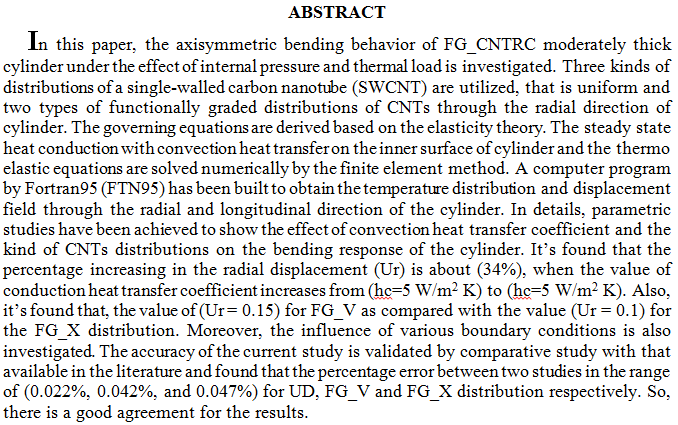
Shadow detection and removal is an important task when dealing with color outdoor images. Shadows are generated by a local and relative absence of light. Shadows are, first of all, a local decrease in the amount of light that reaches a surface. Secondly, they are a local change in the amount of light rejected by a surface toward the observer. Most shadow detection and segmentation methods are based on image analysis. However, some factors will affect the detection result due to the complexity of the circumstances. In this paper a method of segmentation test present to detect shadows from an image and a function concept is used to remove the shadow from an image.
This research is carried out to study the effect of the external post-tensioning technique on the flexural capacity of simply supported composite castellated beam experimentally. In this research, seven composite castellated beams having the same dimensions and material properties were cast and tested up to failure by applied two concentrated loads at 700 mm from each end. Two external strands of 12.7 mm diameter were fixed at each side of the web of strengthening beams and located at depth 180 mm from top fiber of the section (dps) at each end of the beam. The strands have been tensioned by using a hydraulic jack with a constant stress of 100 MPa. This research aims to study the effect of the strengthening by different shapes of st
... Show More (1)
(1)
Abstract
In this investigation, Al2O3 nano material of 50nm particles size were added to the 6061 Al aluminium alloy by using the stir casting technique to fabricate the nanocomposite of 10wt% Al2O3. The experimental results observed that the addition of 10wt% Al2O3 improved the fatigue life and strength of constant and cumulative fatigue. Comparison between the S-N curves behaviour of metal matrix (AA6061) and the nanocomposite 10wt% Al2O3 has been made. The comparison revealed that 12.8% enhancement in fatigue strength at 107cycles due to 10wt% nano reinforcement. Also cumulative fatigue l
... Show More (6)
(6)
Background:Â Various fluids in the oral environment can affect the surface roughness of resin composites. This in vitro study was conducted to determine the influence of the mouth rinses on surface roughness of two methacrylate-based resin (nanofilled and packable composite) and siloraine-based resin composites.
Materials and methods: Disc-shaped specimens (12 mm in diameter and 2mm in height) were prepared from three types of composi
... Show MoreTooth restoration one of the most common procedures in dental practice. The replacement of the entire restoration leads to loss of tooth structure and increase risk of pulp injury; replacement is also time consuming and costly. According to the minimally invasive approach when minimal defects, repair is the better choice than the total replacement of the restoration. This study aims to evaluate repair rating versus replacement treatment procedure for defective composite fillings among Iraqi dentists. Material and methodology: A questionnaire survey were designed and distributed to 184 post-graduate dentists in Iraq. The inquiry pertained general information; including their clinical experience in years, their preference in terms of direct c
... Show More (2)
(2)
 (3)
(3)
 (3)
(3)
Polymer matrix composites are suitable materials for medical applications, such as denture base resin polymethyl methacrylate (PMMA). This includes light weight and high strength. This paper describes the effect of selected weight fractions (1, 2, 3, 4 & 5) % wt of nano(Alumina AL2O3, Zirconia ZrO2, Hydroxyapatite HA and Halloysite nanoClay) reinforcements on the biopolymer matrix (PMMA). Some tribology tests were used to evaluate the prepared system (impact strength, hardness surface, and wear rate) tests. The samples were fabricated by (Hand Lay-Up) with different particle reinforcement percentages. All tests were accomplished at room temperature, and samples were developed according to the ASTM standard. The weight fraction o
... Show More (2)
(2)
 (2)
(2)
Polymer matrix composites are suitable materials for medical applications, such as denture base resin polymethyl methacrylate (PMMA). This includes light weight and high strength. This paper describes the effect of selected weight fractions (1, 2, 3, 4 & 5) % wt of nano(Alumina AL2O3, Zirconia ZrO2, Hydroxyapatite HA and Halloysite nanoClay) reinforcements on the biopolymer matrix (PMMA). Some tribology tests were used to evaluate the prepared system (impact strength, hardness surface, and wear rate) tests. The samples were fabricated by (Hand Lay-Up) with different particle reinforcement percentages. All tests were accomplished at room temperature, and samples were developed according to the ASTM standard. The weight fraction of (4% for AL
... Show More (2)
(2)
The experimental and numerical analysis was performed on pipes suffering large plastic deformation through expanding them using rigid conical shaped mandrels, with three different cone angles (15◦, 25◦, 35◦) and diameters (15, 17, 20) mm. The experimental test for the strain results investigated the expanded areas. A numerical solution of the pipes expansion process was also investigated using the commercial finite element software ANSYS. The strains were measured for each case experimentally by stamping the mesh on the pipe after expanding, then compared with Ansys results. No cracks were generated during the process with the selected angles. It can be concluded that the strain decreased with greater angles of con
... Show More (3)
(3)
Pharmaceuticals have been widely remaining contaminants in wastewater, and diclofenac is the most common pharmaceutical pollutant. Therefore, the removal of diclofenac from aqueous solutions using activated carbon produced by pyrocarbonic acid and microwaves was investigated in this research. Apricot seed powder and pyrophosphoric acid (45 wt%) were selected as raw material and activator respectively, and microwave irradiation technique was used to prepare the activated carbon. The raw material was impregnated in pyrophosphoric acid at 80◦C with an impregnation ratio of 1: 3 (apricot seeds to phosphoric acid), the impregnation time was 4 h, whereas the power of the microwave was 700 watts with a radiation time of 20 min. A series o
... Show More (16)
(16)
